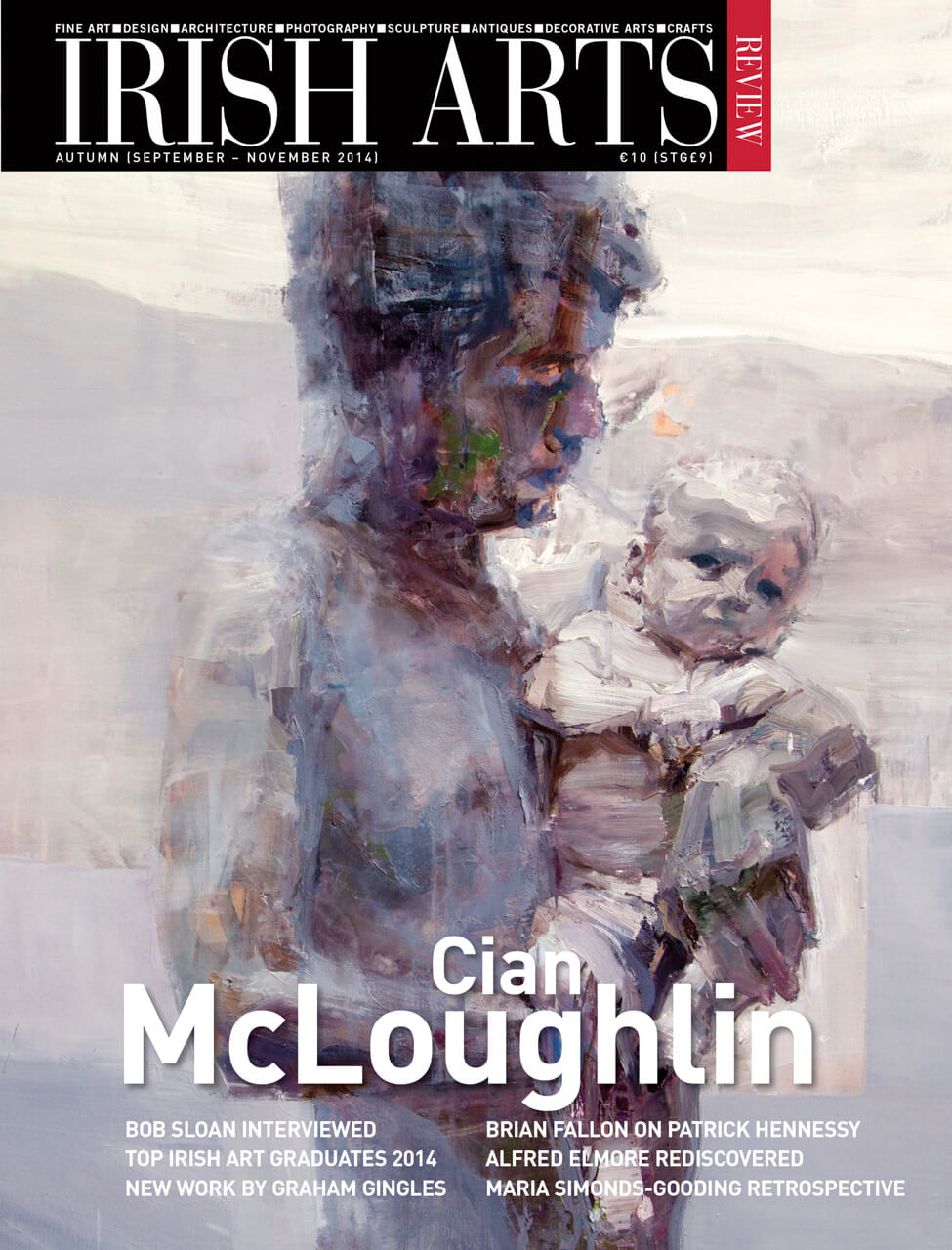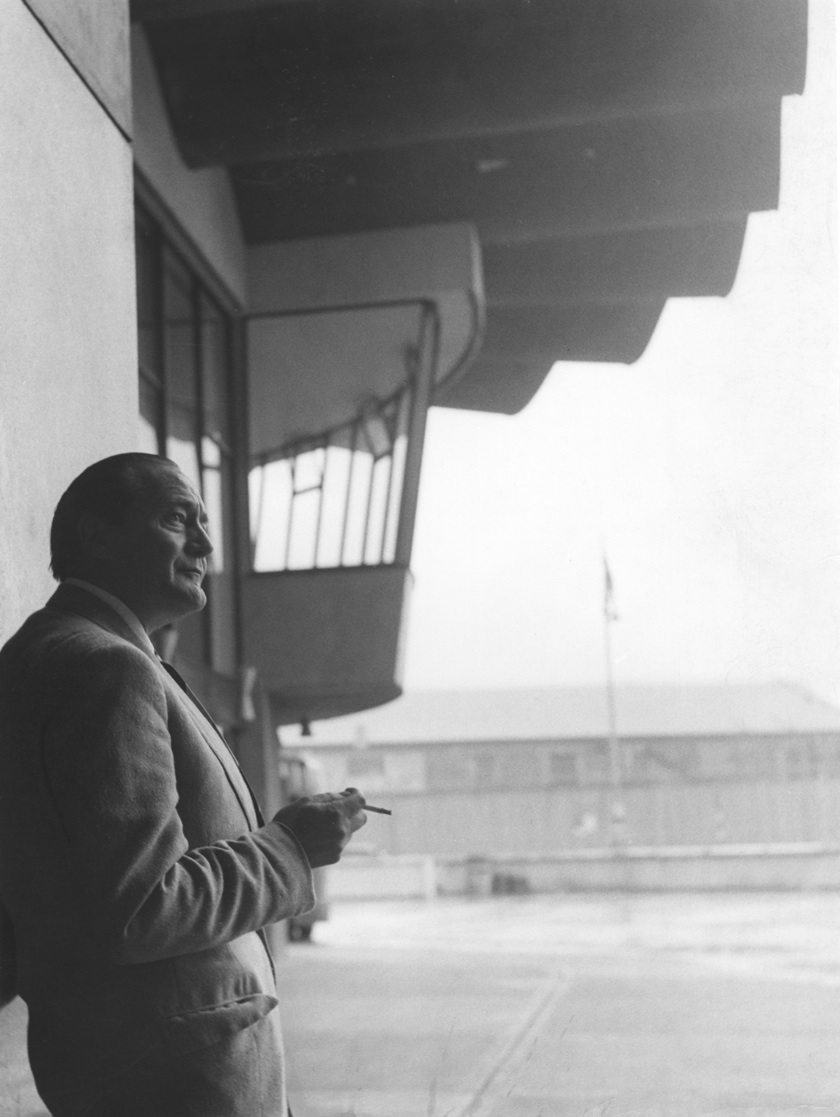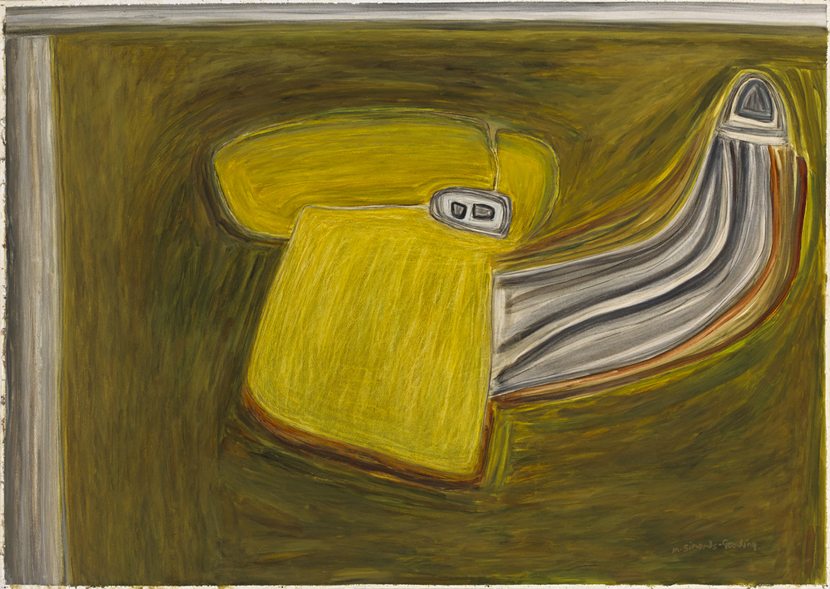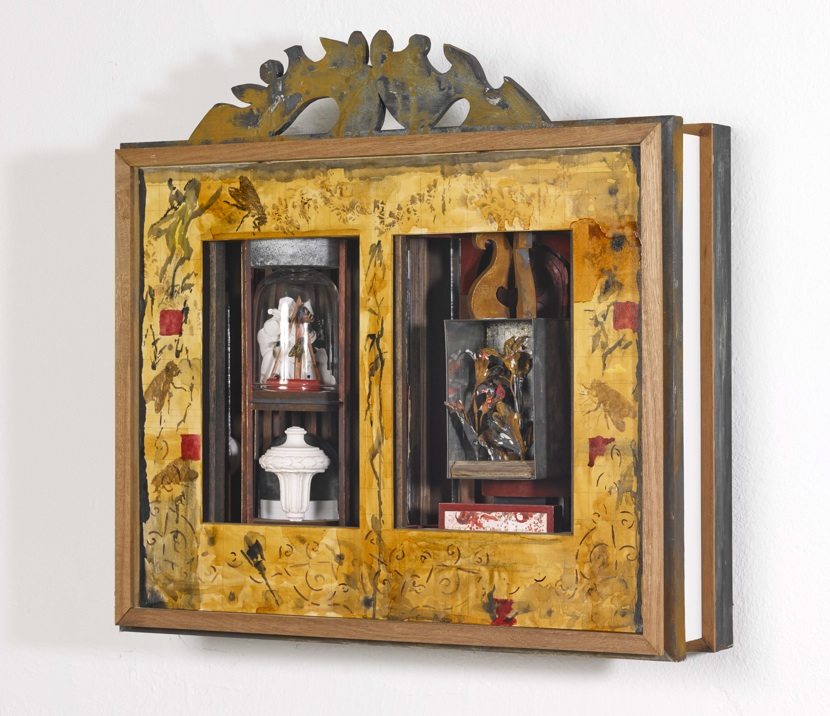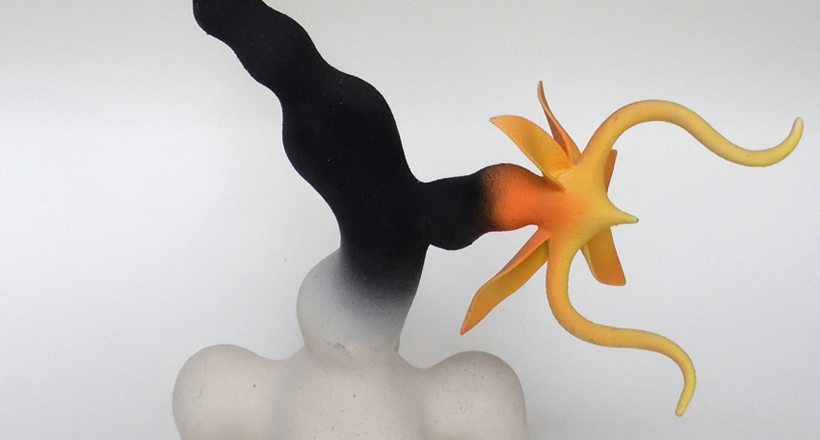
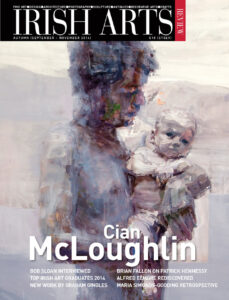
The class of 2014 is looking anew to the tangible joys of creativity, in contrast to its documentation, writes Gerry Walker of the trends emerging from this year’s graduate shows.
View the work of 2014 art graduates in the New Generation Artists Online Gallery in association with New Ireland Assurance.
What characterizes the tone of the many of the graduate shows this year? In part, a refreshing directness; unimpaired by attachments of vast tracts of ‘artspeak’. Previously these inclusions sought to illuminate but more often than not resulted in pretentiousness and obfuscation. Complexity for its own sake is not an inevitable guarantor of quality and mediocrity is not the inevitable consequence of simplicity. There is a discernable re-evaluation taking place, particularly in NCAD, of course durations and their structures which will inevitably impact on a redefinition of fine art for years to come. Established media, drawn from design disciplines hitherto regarded as being separate from the idea of Fine Art, are being reintegrated and synthesized to redefine the artmaking process. Thus the nomenclature of art, design and craft is being scrutinized and recast in favour of eliminating these false distinctions. Work displayed at the highest levels reveals an invigorated engagement with media, materials and their formal elemental interactions.
Limerick’s fashion forte as represented by Eadaoin Ni Drisceoil expresses purposeful creativity, while Letitia Magee’s project from the School of Architecture in Ulster offers a poetic reflection on the process of memory. At the Crawford in Cork Ciarán Kavanagh presents an astute statement on invention and futility. From the Film School in D√∫n Laoghaire, James Fitzgerald’s short film confronts embedded social-cultural issues, and at Dublin’s DIT the subversive power of photomontage as a vehicle for social critique is confirmed by Jason Kearney.
Most significantly however this year’s graduates show themselves willing to re-embrace the concept of Beauty, which had been absent for quite some time. There is a return to the pre-eminence of the product over the documentation of the making process, as seen in the work of ceramicist Etaoin O’Reilly and designer Tom Sweeney. In the recent past documentative postmodern perorations concealed a multitude of sins not least of which was, in a lot of cases, a complete absence of talent. No such circumstances apply here. This inter-collegiate cohort of graduates share a Zeitgeist that champions innovation within tradition. A discernible sense of returning to the verities in order to reconnect and authenticate once more, now that the possibilities of new media have been well digested. This has resulted in boundary breakdown and cross-discipline assertiveness. Their timeline imperative would appear to be: First separate, then define, and then reintegrate. Then finally, rediscover technique.
In the past the European Scholastic tradition forged our notion of what constitutes the ‘Beautiful’ as things and events that give pleasure when they are perceived. Aquinas had three prerequisites for Beauty: integrity, proportion and clarity; discernible qualities in this selection of graduates to watch. Their profound engagement with their chosen disciplines rekindles questions about the vital place of tradition within the visual arts today.
Gerry Walker is a freelance writer and critic.
Etaoin O’Reilly
National College of Art and Design
Most creative people are a mix of craftsperson, designer and artist. Some are more one than the other but Etaoin O’Reilly, a young Dublin-based final-year degree student of ceramics at the National College of Art and Design (NCAD) seems to be a perfect blend of all three. She achieved a first-class honours in her specialist subject and the works shown here come from her graduate exhibition.
Her triffid-like forms are original, beautifully made and convey a disturbing parasitic sense that morph the animal and botanical worlds creating small, slightly sinister sculptural works of high quality and personal style. I am reminded of The Adventures of Baron Von Munchausen and in particular his visits to the Moon where the inhabitants ‘grow upon trees.’ O’Reilly is interested in the contradictions of nature, saying it ‘contributes both beauty and healing – but there is also a darker, and unforgiving side’.
O’Reilly’s talent has already been identified. Earlier this year she scooped the overall prize in the Design and Craft Council of Ireland’s annual ‘Future Makers’ awards. This major prize will provide additional support when she goes to London this autumn to work with the ceramist Kate Malone. Malone is an established maker whose work was recently seen at the Saatchi Gallery in ‘Collect’ and for O’Reilly to be selected by her to be her intern for three months is a remarkable achievement. The experience will provide an insight into creative studio practice: further her hand-building skills and introduce crystalline glazing techniques. One is tempted to think that there may also be an increase in the scale of O’Reilly’s work as Malone is known for her large forms, however this possibility should be approached with caution as that which works so well on an intimate scale may be lost when inflated. It is clear, however, that their common interests in ceramics, hand-building and organic form will ensure that the experience is extremely valuable.
Neil Read’s ceramics are represented in national collections in Ireland, Scotland and China. He was Head of Ceramics, Glass and Metals at the National College of Art and Design until 2010.
Zoe Nolan and Kyle McDonald
National College of Art and Design
There is evidence of a significant directional change in this year’s National College of Art and Design (NCAD) Painting exhibition. Most notably, the scale of the work has altered in favour of the intimate and domestic at the expense of the public or corporate statement. The reasons for this conceptual recasting derive from an ongoing quest for redefinition within the overall Fine Art discipline, and a current major re-evaluation of internal college courses and structures. This exhibition is characterized by a sense of innovation within tradition. The dominant themes explored within that context reveal a fascination with media, materials and formal elemental interactions.
These keynotes are expressed and sustained in Zoe Nolan’s mixed-media work. In an exuberant display of textual manipulation she explores the activity of making marks extending the message beyond the constraints of the rectangle to the surrounding wall space thus lending additional coherence to the primary expression on the canvas. Words appear and disappear in the confusion and mix of creation (Figs 3&4). Nolan describes the problematic aspects of communication in her brief mission statement noting that ‘the marker revives the text that simply got lost in the fuss’. This is a thoughtful, insightful exploration enhanced by its accessible and celebratory tone.
Introspection and material inquiry are the hallmarks of Kyle McDonald’s abstracts (Figs 5&6). His chosen brief addressed some of the attributes associated with Abstraction. In their celebration of painting’s inherent tactile values his work revisits the obvious statement (often forgotten) that a painting is primarily an object, all elements of which demand and reward exploration. This is a significant aspect of the legacy of Abstraction, restated, re-applied, reiterated and wholly understood in its traditional context.
Fundamentally the painting exhibition at NCAD rekindled questions about the place of tradition within painting today and as such it was wholly encouraging. It resonates with elements of rediscovery and consolidation. In education this can be attributed to an almost inevitable temporal dialectic which asserts generational reinterpretation as a constant guarantor of change, evolution and development.
Gerry Walker is a freelance writer and critic.
Jason Kearney
Photography, School of Media, Dublin Institute of Technology
Jason Kearney’s project ‘Cause and Effect’ focuses on issues surrounding a lung condition known as silicosis, which affects those working in the garment industry. Silicosis is caused by the inhalation of deadly fumes from sandblasting, a process employed to achieve a worn look in denim products.
In the completion of the project, Kearney has appropriated the work of American photojournalist Allison Joyce whose 2010 project ‘Fashion Victims’ revealed the dire working conditions of denim factories in Bangladesh. Through photomontage, Kearney has deftly amalgamated Joyce’s images with those culled from magazine advertisements for denim clothing.
In one particular image, the sexualized pose of the model – a mainstay in advertising – is juxtaposed with the accompanying text, which reads Bound by Labour. The model’s pose, with arms raised above the head, has echoes of Michelangelo’s Dying Slave or the mythological tale of Prometheus Bound. This visual link to classic scenes of suffering articulated through the superficial idiom of advertising, sets an effective tone, which oscillates between the sardonic and the poignant.
In the early 1920s Dada artists harnessed the radical and subversive potential of photomontage and here, Kearney proves that the genre remains a compelling vehicle for biting social critique. Furthermore, the inherent craft aspect of photomontage: the cut, the paste or the suture is a fitting medium to employ in an exploration of the garment industry.
While probing big business’ insatiable desire for growing profit margins, one of the ultimate strengths of the work lies in its appeal to the viewer to consider the ethical implications of their own consumption.
Sarah Allen is an arts writer and journalist.
Eadaoin Ni Drisceoil
Limerick School of Art and Design
Eadaoin Ni Drisceoil is the recipient of the inaugural Irish Fashion Incubation Limerick Bursary. This is not a student placement but a real job for a capable fashion designer. She will be based in Paris working alongside the highly accomplished international designer Sharon Wauchob who hails from Co Tyrone.
Ni Drisceoil studied fashion design at Limerick School of Art and Design (LSAD), an institution listed in the top fifty fashion colleges in the world. Winning the IFIL prize here, in competition with twenty-six other graduating designers with international work experience, testifies to her distinction.
Ni Drisceoil exhudes an aura of quiet confidence. Her understanding of the fashion business is already mature. And her appreciation that creativity must have a purpose is crucial in the context of fashion and its fiercely competitive marketplace. Acutely aware of the scope of the business; she is keen to learn more about photography, styling, production and technology. This holistic approach is central to developing a career as a Creative Director at her own label or for one of the leading international brands.
Somewhat unusually for a recent graduate, references to consumers and to the ability of a designer to respond to the needs of the market ‘season’ her conversation.
In selecting the IFIL bursary winner, Sharon Wauchob was consciously looking for someone with the ability to bring a fresh and alternative point of view to the classical influences that often pervade the world’s fashion capitol. Paris offers an exciting opportunity for Eadaoin Ni Drisceoil. I expect she will make her mark.
Eddie Shanahan is Chairperson of the Council of Irish Fashion Designers.
Ciarán Kavanagh
Crawford College of Art and Design, Cork
There is a risk with immersive, Mike Nelson-ish installations in that they can devolve into a kind of arty funfair ride, where the physical experience of navigating through the hermetic trumps any conceptual framework. This danger was avoided by most of this year’s Crawford College of Art and Design (CCAD) graduate students where such work was very much in vogue. Among a strong contingent, Ciarán Kavanagh’s elaborately imagined environment was absorbing, playful and conceptually intriguing. The viewer stepped through the gallery into a workshop cluttered with tools and eviscerated machinery – walls papered with diagrams, charts and the odd sketch of Wiley Coyote. This is the hangout of some strange, obsessive tinker-er, but one with a sense of humour. An observation window focuses on a neat grid of illustrated panels, illegible at this distance – one must go further to investigate (Fig 11). Inscrutable machines populate the dark space beyond; a feather twirls madly inside a glass cylinder and a bicycle wheel contraption spins fitfully. In the opposite corner, painstakingly hand-drawn animations play on old TVs – a worm wriggling on the end of a fish hook, a close-up in pencil of a person trying to start a fire by rubbing sticks together – the task is endless, no sparks result. The wall-mounted grid is composed of the individual animation cells, inscribed on birch-ply panels. This is not simply a whacky inventor’s den, or a miserabilist’s graveyard for thwarted ambition, but a complex and nuanced contemplation of labour, futility, resilience and inventiveness. Kavanagh’s witty paean to ingenuity and failure, to technology’s continual evolution, and to obsolescence and re-invention also works as a subtle meditation on artistic endeavor.
Sarah Kelleher is a recent graduate of the M.A. in Modern and Contemporary Art History in U.C.C. and an independent arts writer based in Cork
Ali Kirby
Sculpture and Combined Media Department, Limerick School of Art and Design
Since arriving in Limerick to study at Limerick School of Art & Design (LSAD), Ali Kirby has been an active member of the local arts community. Her work was selected for the first Ormston House members’ exhibition, ‘Undertow’, curated by Alice Maher and Aideen Barry in 2011, and for the Ormston House City of Culture members’ exhibition, ‘Essays for the House of Memory’, curated by Haizea Barcenilla in 2014. Kirby has become known for her distinctive sculptural arrangements and allusive assemblages, weirdly precarious and sturdy at once, striking a delicate balance between tenuous material relationships and robust structures.
Kirby is a maker of things which hint at a nostalgia for the pre-internet era or, rather, for a more immediate experience of the material world. Decommissioning found objects, repurposing household products and sourcing bland tools, she imagines them afresh. In Lair (Fig 14) a damaged concrete brick is wrapped carefully in a blanket, giving it a particular form it could not achieve alone. Resting on top of the protected brick, a fragrant gelatinous form wobbles tentatively releasing the familiar, homely smell of fabric softener. Each element of the work seems to observe a duty of care to the other.
In Bloc, a substantial concrete monolith stands solid, or so we might think, until we see the bottom corner of the foundation has been cracked (intentionally or accidentally, we might wonder). A soft pink line hugs the concrete and a rectangular length of polystyrene together as though to avoid further disintegration (Fig 13). For Untitled, the artist builds protective barriers of flimsy materials around a concrete central core leaving it barely visible – but with just enough air to breathe. The consistent colour palette throughout this body of work: pale pinks, dusty yellows and turquoise blobs pop against the gradient of industrial greys.
Mary Conlon is a PhD candidate at Limerick School of Art & Design and Director of Ormston House, Limerick.
Tom Sweeney
Galway-Mayo Institute of Technology Letterfrack
Tom Sweeney is a graduate of the B.Sc. (Honours) programme in Furniture Design and Manufacture at the National Centre of Excellence in Furniture Design and Technology, at GMIT Letterfrack, Co Galway.
As a designer, his work is embedded in traditional furniture-making techniques while exploring the most up-to-date digital technologies from the fields of architecture and engineering. His craft ability was enhanced during his work placement at Benchmark in the UK, a company founded by Sean Sutcliffe and Terence Conran, specializing in innovative, contemporary English furniture.
The distinguishing character of Sweeney’s work lies in its blend of tradition with technology. During the process of realizing his design concepts, he identifies and solves problems of manufacturing. ‘After Dark’ was the theme he chose for his final-year work, which involved the creation of two skilfully executed designs. One, a high-end interior wall-cladding system entitled Weave (Fig 15), and the other a process-led pendant lamp. Weave is designed as a single triangular component, made from MDF and finished with satin lacquer. The result is an eye-catching interplay of light; the textured wall creating an optical illusion. In the design for Rivet lamp he explores the inherent qualities of copper, to create a free-form lampshade with open riveting. It is based on pattern-making techniques used by traditional tinsmiths.
Tom Sweeney has already received recognition for his work. In 2011 he was winner of the House and Home Crafts Council of Ireland Student Design Award for a modular, wall-mounted mini storage system (Fig 16). While at Benchmark he worked on a project for a new reading chair that was shortlisted for the Oxford University Bodleian Libraries Chair Competition. Proving to be a name to watch, Sweeney was awarded a Material Bursary Award by the Design and Crafts Council of Ireland, Future Makers and Awards Supports in June 2014 for his final-year work.
Susan Rogers is a lecturer in Furniture and Design History at GMIT Letterfrack, the National Centre of Excellence in Furniture Design and Technology.
James Fitzgerald
The National Film School at D√∫n Laoghaire Institute of Art, Design & Technology
There’s a ‘Flick’ in every small town across the country: a kid with potential who wastes his young years on drink and on a pantomime of a dead-eyed-self forty years’ older. Skunky Dog is set in Connemara but it could be in any county. In fact, director James Fitzgerald drew the inspiration for his substantial short film from Dunmore East, Co Waterford, where he moved with his family when he was eight. During the winter months, he was struck by a sense of hopelessness that pervaded the town, a sense that time had stood still, and a sense that intimacy, between men, or between men and women, is a betrayal, a reminder of the shame of a shared loneliness.
Shane Meadows is an acknowledged influence, and like Meadows, performance is at the heart of Fitzgerald’s filmmaking. Ryan MacParland, who was so impressive in Good Vibrations, plays the lead. From the opening we are convinced by his portrayal of a character at war with himself. David McSavage turns up as a barman and the rest of the supporting cast are as flawless in their depiction of the frustrations and boredom of small town life.
The story of Skunky Dog is simple enough. Poor Flick, the skunky dog of the title, meets Sue, a widow with two children, and for the first time in his life, things are looking up. It is uncomfortable and heart-wrenching to watch Flick destroy what might be his last chance to get away from his abusive dad, his dead-end town, and from his skunky self.
Shot on a RED camera by Aidan Gault – also a student at the National Film School – the film looks stark and redolent. In fact the editing, sound design, costume and make-up contribute to the film’s high production values.
Fitzgerald dedicated his film to his dad who passed last year and who would have been as thrilled as the rest of the audience at the film school screenings at the Lighthouse Cinema. The emotional depth conveyed in this project is both a thrill and a rare occurrence in student or short filmmaking.
James Fitzgerald has plans to make some really interesting work. His Skunky Dog presents us with the ugly frustrations of a kid who never made it past the end of the bar.
Paul Freaney is Academic Tutor on the Film Degree Programme and Co-ordinator of the Masters in Screenwriting at the National Film School at IADT.
Letitia Magee
The Belfast School of Architecture, University of Ulster
The beauty of the work of Letitia Magee lies in her poetic reflection on the memory of place within a rigorously practical architectural response.
Magee has observed that ‘although dearly held memories are transient, shifting and fading, the landscape which facilitated and witnessed them, endures. The land is a storehouse of private and collective memories, ready to be tapped into.’
The site of Magee’s project is located within the natural beauty of the Glens of Antrim, close to the confines of the coastal town of Glenarm where the loss of industry has led to dereliction in recent years. Magee’s final-year design proposed a small-scale industrial sawmill for Glenarm forest to respond to a very specific need. Japanese larch is widespread within the forest, but unfortunately the species is diseased and thus felling of this species is required. Magee designed a shelter for the larch cull, which would efficiently remove the diseased trees and restore them to usable lumber. The simplicity of the scheme is admirable and this is where its beauty originates: in its tectonic clarity. Through the detailing of a temporary and refined structure set onto a permanent concrete plinth, acting as a memorial to the lost trees, the building hints at the transient nature of place and the permanence of memorial.
While unassuming, Letitia Magee’s scheme is anything but ordinary. Her ability to transcend the ordinary is remarkable and I look forward to seeing how she creates extraordinary places in future years.
Jenny Russell is Associate Head of School at the Belfast School of Architecture, University of Ulster.
